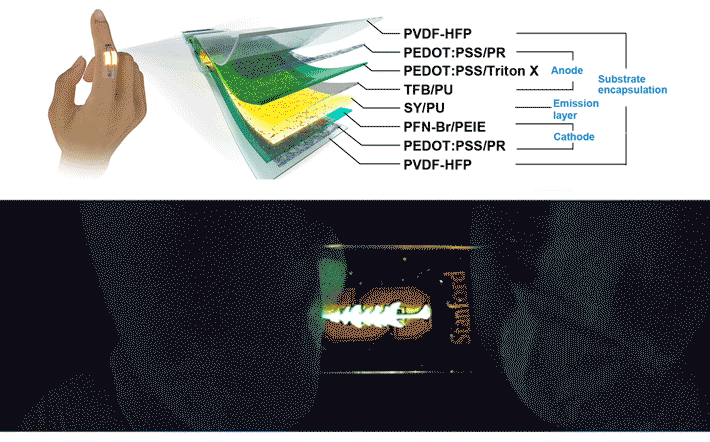By continuously monitoring physiological signals (pulse, breath rate, blood pressure, etc.), wearable “stick-on” sensors not only help people stay healthy, they can also provide early warning of potential health problems. But to retain functionality throughout multiple bending cycles, wearable electronic displays need to be both stretchable and bright.
Previously reported stretchable light-emitting diodes (LEDs) were mostly based on inorganic nanomaterials that require high operating voltages or have limited stretchability, brightness, resolution, or robustness under strain.
In contrast, all-polymer light-emitting diodes (APLEDs) could be an ideal platform for displays on skin, considering their low driving voltage, high brightness, fast response time, long-term stability, and solution-based processing. However, the desired combination of high stretchability and brightness (i.e., good charge-transport properties) has remained elusive.
In this work, researchers studied thin films in which a widely used light-emitting polymer, known as “Super Yellow” (SY), is constrained to nanosized dimensions in a flexible polyurethane (PU) matrix. Nanoconfinement is known to modify a material’s electronic and thermodynamic properties.
“This strategy allowed us to achieve enhanced stretchability and charge transport with improved ductility while suppressing the crystallinity of the confined polymer,” said Zhenan Bao, a professor of chemical engineering at Stanford University who led the study.
Resonant soft x-ray scattering (RSoXS) experiments at ALS Beamline 11.0.1.2 provided structural information about the domain spacing of individual components in the SY/PU mix.
“With unique chemical sensitivity enabled by tunable soft x-ray energies,” said ALS staff scientist Cheng Wang, “RSoXS provides important details about the nanoconfined morphology of the active material, which is key to controlling and optimizing structure and performance.”
The SY/PU light-emitting layer was then combined with transparent, stretchable, and high-conductivity polymer electrodes with suitable interface modifications to produce stretchable APLEDs possessing high brightness, current efficiency, and stretchability. In addition to the yellow APLEDs, the researchers also fabricated red, green, and blue versions, capable of displaying pulse signals in real time using on-skin wireless power—a considerable advancement toward high-performance stretchable displays.

Z. Zhang, W. Wang, Y. Jiang, Y.-X. Wang, Y. Wu, J.-C. Lai, S. Niu, C. Xu, C.-C. Shih, C. Wang, H. Yan, L. Galuska, N. Prine, H.-C. Wu, D. Zhong, G. Chen, N. Matsuhisa, Y. Zheng, Z. Yu, Y. Wang, R. Dauskardt, X. Gu, J.B.-H. Tok, and Z. Bao, “High-brightness all-polymer stretchable LED with charge-trapping dilution,” Nature 603, 624 (2022), doi:10.1038/s41586-022-04400-1.